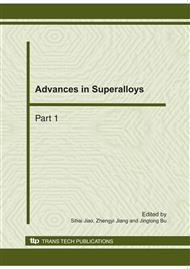p.349
p.353
p.357
p.361
p.366
p.370
p.374
p.378
p.382
Micromechanical Strength of Particle in Composite Ceramic with Partial Debonding Interphase
Abstract:
The four-phase model is used to predict the strength of particles in composite ceramic with partial debonding interphase. Firstly the external strain of three-phase cell is determined. Based on the disturbance strain tensor of three-phase cell, the micromechanical stress field of the particle is obtained. Then based on the generalized thermodynamic force of the particle in damage process, the damage equivalent stress of the particle in the three-phase cell can be calculated. As the damage equivalent stress is equal to the ultimate stress of the particle, the micromechanical strength of particles in composite ceramic with partial debonding interphase is obtained. Finally, For Al2O3-ZrO2 composite ceramic with partial debonding interphase, the variations of the micromechanical strength of particles for different orientation angle and different particle diameter are analyzed. The result shows that the micromechanical strength of particles is determined by the 50° orientation three phase cell, and has obvious size dependence. The micromechanical strength of particle will decrease when the particle diameter increase.
Info:
Periodical:
Pages:
366-369
Citation:
Online since:
October 2010
Authors:
Price:
Сopyright:
© 2011 Trans Tech Publications Ltd. All Rights Reserved
Share:
Citation:


